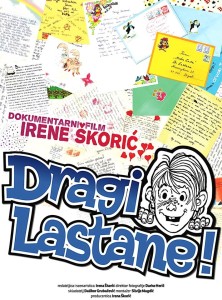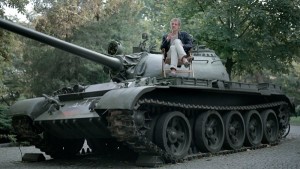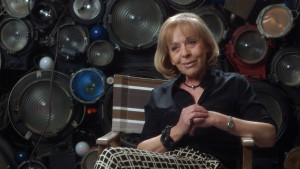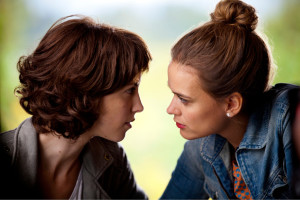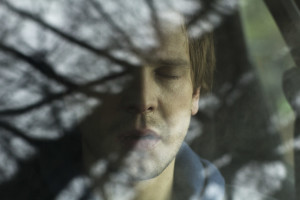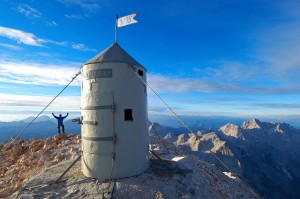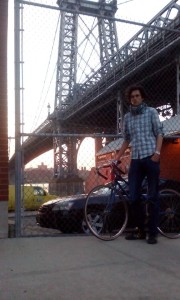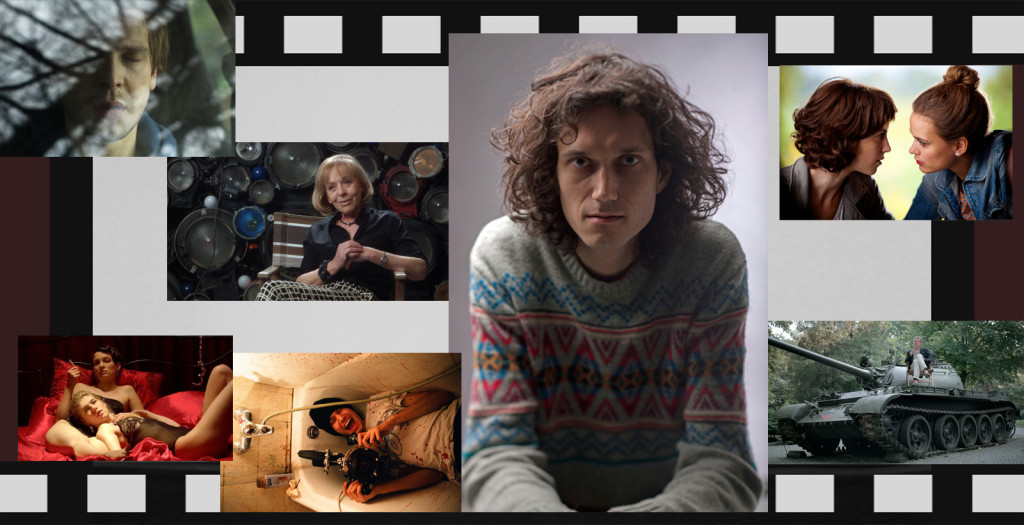
Cinematographer Darko Herič (Portrait ©Pavel Posavec; Bathtub ©Barbara Vekarić) surrounded by the stills from his films Dual (top right, ©Simon Gaberščik), There Once Was a Land of Hardworking People (bottom right, ©Darko Herič), 7 sex 7 (bottom far left, ©Darko Herič), What about Mojca (center left, ©Darko Herič), Inhale (top far left, ©Darko Herič). Collage by Marta Stemberger.
“Look how the windows are catching the light. It’s beautiful,” said the lanky young man as he stopped on top of the stairs, above the Houston Street’s traffic. “I’ve heard that there’s an avenue in NYC through which you can see the sun setting on a particular day of the year.”
“Mhm, the sunset is always beautiful to watch at the Christopher’s street pier in West Village”, I answered.
It turns out that on a couple of spring and summer evenings every year “the setting Sun aligns precisely with the Manhattan street grid, creating a radiant glow of light across Manhattan’s brick and steel canyons, simultaneously illuminating both the north and south sides of every cross street of the borough’s grid.” It’s called Manhattanhenge.
Darko Herič is a very talented, promising, and prolific Slovene cinematographer with the M.A. degree in Cinematography from the Academy of Dramatic Arts in Zagreb, Croatia. He is the Slovene artist-in-residence in Brooklyn this May. We met at the Angelika Film Center’s café at the juncture of SoHo, West and East Villages.
FIRST WE TAKE BERLIN, THEN WE TAKE MANHATTAN
Marta Stemberger: You wrote on your Facebook page that you moved to Brooklyn?
Darko Herič: Yes, I moved in for a month, and then I’ll move out.
Marta Stemberger: Why did you choose New York, and not London, Berlin, or Vienna where Slovene Ministry of Culture also maintains the artist’s residence?
Darko Herič: I was looking for a city that’s the most connected with cinema. Well, Berlin is too. I was in Berlin last year at the Berlinale Talents, which is the annual summit and networking platform of the Berlin International Film Festival for 300 emerging film creatives from all over the world. We were two from Slovenia. There were different workshops, lectures; one could go to all the screenings.
Vienna is very close and I visit often. Perhaps London, but I was there a few times already as well. I was in New York in 2011 when we were filming a documentary with Janez Janša. We were here, in Los Angeles, and Vancouver.
Anyway, I decided to go to New York this year. I was planning to meet with a few colleagues who studied camera at the same university in Zagreb as I did, and now work here. Well, it turns out that they are all filming all over the world in May. I also want to get together with people I met at Berlinale. I’ve already met two of them yesterday: one’s from China and one from New Orleans, but they work and live in NYC. We’re thinking about doing a project together.
Marta Stemberger: You will have a few screenings of your films while visiting the U.S., right?
Darko Herič: Yes, there will be two screenings: a Croatian film Dragi Lastane! (Dear Lastan, 2014) at the Bosnian-Herzegovinian Film Festival on May 21 in New York, and a Slovene film Kaj pa Mojca? (What about Mojca?, 2014) on May 28 in Washington, D.C.
The documentary Dear Lastan is about the children’s magazine Modra Lasta (The Blue Swallow), published in Zagreb since 1954. Since 1969, the publication had a fictional character Lastan to whom children wrote letters with their problems, and he’d be answering. The magazine used to be spread across the former Yugoslavia. We were looking for people who wrote in and received the answers, and we interviewed them. We also interviewed those who were the Lastan character. There were four of them.
Marta Stemberger: One day before the screening of Dear Lastan, a few short films by Karpo Godina, probably the most internationally acclaimed Slovenian filmmaker and cinematographer, will be shown in Seattle, WA. An interesting coincidence. Have you worked with him? Has his work influenced yours?
Darko Herič: I haven’t worked with Karpo Godina, but I know him personally. His films had great influence on me, especially his shorts documentaries: 14441 kvadrata (14441 Frames, 1972), Gratinirani mozak (Gratinated Brains, 1970) and Zdravi ljudi za razonodu (Healthy People for Fun, 1971). They were filmed with excellent humor and artistic, stylized use of all film resources.
HOW TO MAKE THE STARS SHINE
Marta Stemberger: How did you get to work on the two Slovene films, considered for the screening in Washington, D.C.: Kaj pa Mojca? (What about Mojca?, 2014) and Nekoč je bila dežela pridnih (There Once Was a Land of Hardworking People, 2012).
Darko Herič: Urša Menart, the director for both, contacted me through the producer Sever & Sever Productions for the Land of Hardworking People, and we clicked. The idea was to present the interviewed people in typical Slovene postcard scenes. The whole film was shut on location, and is visually very strong because of that. We were driving around Slovenia for a month or two, trying to find locations. But we ended up with the ones close to Ljubljana. It would be too far and too expensive otherwise.
Marta Stemberger: Too far and too expensive in Slovenia?
Darko Herič: Yeah, I know, everything is so close, but still. At the end, we did well. The film played in theaters for a couple of months.
The idea was to present people in typical Slovene postcard scenes. @DarkoHeric #SloConnect Click To Tweet
Marta Stemberger: So the work for the Land of Hardworking People was completely different than for What about Mojca?
Darko Herič: At the VIBA Film, we found the storage with old equipment, old lights just lying around. We created scenery out of these, and filmed all the interviews in a hall there.
I wanted to honor Slovene actresses; softer light lets them shine even more. @DarkoHeric #SloConnect Click To Tweet
Marta Stemberger: Mhm, interesting. So it was a technological excursion into the past?
Darko Herič: Yes. Nowadays, the trend is completely different, more natural light. But I wanted to use different lenses, softer light, a diffuse image so that they can shine even more. That was important for me, and I enjoyed it.
SLOVENE CINEMA, FILM FESTIVALS, AND BEYOND
Marta Stemberger: All three films we mentioned so far are documentaries. Are you drawn more to documentaries?
Darko Herič: No, I film everything. It just so happens that right now I’m working on many documentaries. Even when I return in June, I’ll be shooting two documentaries. But I also work on short fiction and feature films. In February, I was doing a TV series, and I just finished a show for RTV Slovenia. It varies.
Marta Stemberger: How do you select your projects?
Darko Herič: I look for a good story, a good idea. And if I click with the director. I work mostly with friends, people I’ve known for a while.
I was personally very motivated with the two Slovene documentaries we mentioned; I enjoyed taking on the challenge. With Urša Menart, the director for both of these films, we had discussions how to make “talking heads” documentaries. They are basically composed of portraits of people who talk. How to make it differently? How to make it interesting? And not just the same typical TV documentary where you film a person who talks, and then you edit it with something that fits. I think we succeeded very well. It has even been copied. There were a few films that have been clearly influenced by the way of filming and editing in the Land of Hardworking People. So we spearheaded a way forward.
The way we filmed Land of Hardworking People has been copied in Slovenia. @DarkoHeric #SloConnect Click To Tweet
Marta Stemberger: You spearheaded a way forward in Slovenia. What about elsewhere? Where these two documentaries shown anywhere else?
Darko Herič: They were both shown at the Slovene Film Festival in 2012 and 2014. The Land of Hardworking People was also at Zagreb DOX and SEE a Paris Docs, both in 2013. What about Mojca was at the Trieste Film Festival earlier this year. But I’m not aware of any international commercial distribution.
Marta Stemberger: What about Mojca will also be shown in Washington, D.C., as part of the European Month of Culture on May 28.
Darko Herič: Yes. I offered the Land of Hardworking People and What about Mojca when talking with the Slovene Embassy to organize some screenings. I was thinking which of my films show Slovenia the most, and I decided on these two. For a presentation in the U.S., I reckoned that it would be good to somehow connect film and national consciousness. Even though I have short fiction and feature films, which are also good and interesting.
Marta Stemberger: How do you see your films, and Slovene cinema in general, being accepted abroad, including the U.S.?
Darko Herič: There are mainly screenings at the festivals. In 2012, my first feature movie 7 sex 7 was shown at the International Film Festival WorldFest in Houston, USA, and won the Silver Remy award. It’s a Croatian film, directed by Irena Škorić, who also directed Dear Lastan.
Marta Stemberger: Your second feature movie Dvojina (Dual, 2013) by Nejc Gazvoda was also well received. I found some good reviews online: “Beautifully shot by Darko Herič” (Mark Adams, Screen Daily) and “As well as being alert to the smallest changes in expression, Darko Heric’s camerawork showcases the emptiness of the nighttime city, but for two ambling souls, an eloquent visual corollary to the new intimacy that’s unfolding” (Sheri Linden, The Hollywood Reporter).
Feature film Dual is “beautifully shot by Darko Herič” (Mark Adams, Screen Daily). #SloConnect Click To Tweet
Darko Herič: Yes, but the last movie with a greater breakthrough was Razredni sovražnik (Class Enemy, 2013) by director Rok Biček and cinematographer Fabio Stoll, which had a regular theater distribution in Italy and France. I don’t recall any other movie to have such appeal in the last few years.
Marta Stemberger: At the beginning of May, some Slovene films were shown at the South East European Film Festival in Los Angeles. And a series of short films by Karpo Godina and Davorin Marc have been screened in the theaters in NYC and along the Pacific coast since March.
Darko Herič: Again, these are festivals, one or two screenings at each, but commercial distribution is very limited. Slovene cinema is a marginal European cinema. Perhaps the new movie Houston, We Have a Problem by Žiga Virc can be hot internationally. It’ll be released later this year, or next year.
Marta Stemberger: What about production from other former Yugoslavian republics? Emir Kusturica was very well known all over the world.
Darko Herič: Yes, he won in Cannes. And that’s that. If you attend such a top film festival as Cannes and even win, that is certainly a very good ticket for the international playground.
This year, the Croatian-Slovene co-production Zvizdan (Zenith) by the Croatian director Dalibor Matanić will be in Cannes. My Slovene colleague Marko Brdar was the director of photography. This one has a chance to be noticed. The festival is May 13 through May 24.
And my short fiction film Vdih (Inhale, 2015), directed by Blaž Završnik, will be screened at the Short Film Corner. It’s about an old recluse who prevents a young man’s suicide. He takes him to his house in the middle of the forest where they spend the Christmas eve together.
Marta Stemberger: Congratulations! We’ll keep our fingers crossed.
WHOSE IS THE LAND WE LIVE ON
Marta Stemberger: You mainly work with others. Are you interested in writing, directing and shooting your own film?
Darko Herič: Yes, I am. I have a few ideas. I’ve been preparing a documentary for quite some time now. But every time I get more into it, I receive a bunch of other projects to shoot, and I have to put my own on hold.
Marta Stemberger: What is the theme?
Darko Herič: The working title is Čigava je Slovenija? (Whose is Slovenia?). The point is that it doesn’t belong to anyone. It simply is and we live there. In 100 years, someone else may live where we live now. We cannot own this piece of land, or say that is ours. The area of Slovenia has been on crossroads throughout history, on the draught as it were; people passed through it, moved in and out. Through the interviews with different people, I’d like to show this, to expose the view on our national identity, which basically doesn’t exist, even though there’s an attempt to create it artificially. It’s very strong in Croatians, but not in us.
Marta Stemberger: What about language? Don’t we identify as Slovenians with our Slovene language?
Darko Herič: Yes, we do. That’s one of the themes as well.
Marta Stemberger: How did you come to the idea about whose Slovenia is?
Darko Herič: Once I heard someone say: “Who will live in this gem under Triglav 100 years from now if not us Slovenians?” And it got me thinking: “I don’t know who it will be. Someone will.” Who was here 500 years ago? Some parts of nature are much older than we are. We cannot measure up to Triglav. The Aljaž’s Tower is now 120 years old. If left alone, it will be blown away in 10-15 years. We are so fragile and vulnerable. It’s odd that we claim to be the owner of something that is much larger than us. The economic crisis and the crisis of values in Slovenia emphasized these questions. How can I contribute as an artist? Well, I can make a film. It’s been three years now. The script is done.
It’s odd to claim to own something that is much larger than us. @DarkoHeric #SloConnect Click To Tweet
Marta Stemberger: Interesting. You are focusing on Slovenia, but it can be applied to other countries as well.
Darko Herič: Yes, but I would like to exclude politics and political orientations. I’d like to distance myself from it as much as possible, and focus more on the human and ecological side.
Marta Stemberger: Mhm, yes, that’s stronger than politics.
Darko Herič: From ecological perspective, for example, the first diaper was made 50 years ago. Each diaper takes 500 years to disintegrate. So the first diaper will disintegrate in 450 years. That’s such an abstract number for one of us. 450 years? What was 450 years ago? It’s difficult to project into the future: what will be, what things will mean. How will things that we do now affect people in the future? 500 years ago, they didn’t make things that would take 500 years to disintegrate. Today, we find what they did as archeological remains, which are used to explain their society. Perhaps it’s good that we pollute so that they’ll know in the future how we lived.
The first diaper, made 50 years ago, will disintegrate in 450 years. @DarkoHeric #SloConnect Click To Tweet
Marta Stemberger: So archeological finds 1000 years from now will be plastic.
Darko Herič: Yes, maybe. All that’s left from previous civilizations are stone and metal items; so we think that they weren’t advanced, that they only had what we find. But perhaps they were much more advanced and created only biodegradable things, and so nothing remained. Perhaps they were thoughtful about what they would leave for the future generations.
GOALS FOR THE FUTURE
Marta Stemberger: What are your goals for the future?
Darko Herič: I would like to work internationally. I’m not limited by language, as are actors, script writers, even directors. I express my art through visual language, and would like to do so on the international scene. In Slovenia, the possibilities are still quite limited. Yes, there are projects, but not that many.
Berlinale last year and New York this year are steps in the international direction. But I don’t know, I cannot foresee what will develop.
Marta Stemberger: What is your approach to get more worldwide exposure?
Darko Herič: Through personal connections with directors, producers. I think this is the best way to get to know a person directly and see if there’s compatibility, if you click. Recommendations, personal contacts, festivals. There is no recipe. People who succeeded had mostly some combination of luck and skills. To be at the right place at the right time. Success doesn’t necessarily mean to be a known star. There are many people who aren’t stars but create good stuff.
Success doesn’t necessarily mean to be a known star. @DarkoHeric #SloConnect Click To Tweet
Marta Stemberger: What is the most important to you when you are making a film?
Darko Herič: Good relations with all team members. This makes many things possible. It’s nicer, easier to work if the atmosphere is good. Even though a good atmosphere doesn’t necessarily mean that the film will be good.
Marta Stemberger: Where would you ideally like to work and live?
Darko Herič: I would probably never fully move to another country. I would work abroad for a while, and then return to Slovenia. I like Slovenia, I wouldn’t want to leave it for good. I like the people, I like how everything is still fairly simple. If you don’t need lots of money to feel important, if you are happy with moderate means, then life in Slovenia is much quieter than elsewhere. It’s also cleaner. Here in New York, I noticed all these signs about were one should and shouldn’t throw garbage. Perhaps people in NYC don’t feel that they belong. I think that in Slovenia we are more conscious about garbage because we may be more connected to our surroundings.
Perhaps people in NYC don’t feel that they belong. @DarkoHeric #SloConnect Click To Tweet
When I arrived at the Brooklyn apartment, I found an old bicycle and I’m riding around the City with it. Yesterday, I found an old basketball. I was tapping it for about 15 minutes as I was walking on the street. When I got back to my new home, my hands were all black with dirt. A good ball thrown away and dirty.
Darko Herič will move out of the Brooklyn residence at the end of May, but he will return to the U.S. in October to attend the Master Class in Cinematography by the American Society of Cinematographers (ASC) in Hollywood. “It consists of 5 days of intensive seminars and workshops with some of the world’s greatest cinematographers who share their knowledge and skills with aspiring film-makers such as myself”, he says and adds, “I’m always looking for ways to expand on my knowledge of cinematography.”
The short version of this interview was published in the Newsletter of Slovene Embassy in Washington, D.C., on May 29, 2015.


